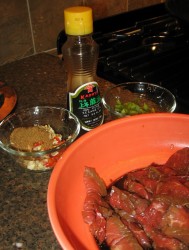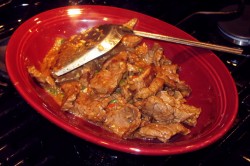From Revolutionary Chinese Cookbook: Beef With Cumin
Cumin is one of my favorite spices; however, it is not a flavor one overwhelmingly associates with Chinese food. Rather, it is better known as an ingredient in Indian curries, Mexican braises and Mediterranean stews, so I was intrigued to see this recipe when I first got my hands on my copy of Revolutionary Chinese Cookbook.
Not surprisingly, beef with cumin is a specialty of the Muslim minority in China, and it is likely that cumin was brought to China along the silk road by spice traders from the Middle East and India.
The ingredient list is short and simple for this dish, and although Dunlop notes that one could use prime cuts of steak such as tenderloin to make it, she uses lesser cuts such as round and chuck, because cutting them thinly, on the bias against the grain, makes them nearly as tender as a more naturally tender cut of beef. I used a piece of top round to great effect here, in large part because that is what I had in my freezer. Left partially frozen and cut nearly paper thin with a very sharp knife, top round is just as wonderfully tender as a porterhouse steak, but with a deep beefy flavor typical of the tougher, more well-exercised muscles.At this point, I use top round for nearly all of my beef stir fries.
I do have to admit that I changed the cooking method. Dunlop uses the “velveting” method of cooking here; it is a method much employed by restaurants to cook meats to a slippery-tender result, but which I find messy, wasteful and extremely time consuming when done in the home. In short, it is a technique wherein the meat is marinated in a mixture that includes corn or potato starch and sometimes egg white. Then, it is “oil-blanched” in a vat of deep-frying oil for a very short time until it is partially cooked. Then, the oil is discarded or strained and saved, and the meat is stir fried until it is finished cooking, along with all of the other ingredients of the dish.
For a family dinner, I see no overwhelming reason to bother with the velveting technique. It results in the use of too much oil, time and energy for the result, which while it is good–is not -that- good! Not good enough to offset all of the work, mess, waste and nutritional impact.
So, instead, I followed my own usual method for stir frying meat, and found that the results were more than satisfactory; they were superb. In transcribing the recipe, I used my own techniques instead of copying out Dunlop’s.
The meat was tender and flavorful, and fragrant with the musky scent of cumin, which was beautifully enhanced by the umami of the soy sauces. Garlic, scallion and sesame oil rounded out the flavors while the bright taste of fresh red chiles really sent the dish over the top.
The stir fry went together quickly and easily and went beautifully well with a dish of gai lan and sweet red bell peppers simply stir fried and flavored with ginger and fermented black beans.
This is another dish destined to be seen on our table frequently.
Beef With Cumin
Ingredients:
1 pound trimmed beef top round steak, cut against the grain on the bias about 1/8-1/4″ thick
1 1/2 tablespoons Shao Hsing wine
1 teaspoon light soy sauce
1 1/2 teaspoon dark soy sauce
1 tablespoon cornstarch
3 tablespoons peanut oil
2 teaspoons fresh ginger, peeled and minced
1 tablespoon finely chopped fresh garlic
2 fresh red chiles, (seeded if you like) minced
2-4 teaspoons dried chile flakes
2 teaspoons ground cumin
1-3 tablespoons Shao Hsing wine as needed
2 scallions, green parts only, finely sliced on the bias
1 teaspoon sesame oil
Method:
Toss the beef in the wine, soy sauces and cornstarch until it is well coated with the mixture. Allow to marinate at room temperature for at least twenty minutes.
Heat wok on high heat until a thin thread of smoke rises from it. Add peanut oil and heat for another thirty seconds or so. Add beef, reserving any remaining liquid marinade in the bowl. Spread beef out into a single layer over the bottom of the wok and allow to sit undisturbed for at least a minute so it can sear. When you smell it browning and the top edges begin to turn greyish brown, then begin stir frying vigorously.
While stirring, sprinkle meat with ginger, garlic, chiles, chile flakes, and cumin. Continue stir frying just until all of the red color is gone from the meat, adding a bit of Shao Hsing wine as needed to deglaze any browned bits from the bottom or sides of the wok. Add any liquid marinade and stir fry just until the liquid thickens and clings to the meat.
Sprinkle with scallion tops, and drizzle with sesame oil. Remove from heat, give a few more stirs and then serve on a heated platter with plain steamed rice and a vegetable dish.
18 Comments
RSS feed for comments on this post.
Sorry, the comment form is closed at this time.
Powered by WordPress. Graphics by Zak Kramer.
Design update by Daniel Trout.
Entries and comments feeds.





Can chinese cooking wine be used if the other is not available?
Comment by tudorpot — January 19, 2007 #
Looks scrumptious and easy! Thanks for posting it.
Comment by Kim — January 19, 2007 #
I’ll say that velvet technique sounds time consuming and messy! Yours is much better.
I enjoy cumin.
Comment by tanna — January 21, 2007 #
I’ve been using cumin with soy sauce for ages. I thought it was “wrong” (I came to cumin through a love of Indian food). But it tastes sooooo good together! LOL
Comment by Steph in the UK — January 21, 2007 #
Thank you for giving me permission to let go of velveting! I’ve always hated doing it and now I’ll be OK with skipping that part of the recipe.
Comment by Ann Harste — January 22, 2007 #
I gave this a try this evening – I didn’t have the more exotic ingredients (the wine, the sesame oil) but I had everything else, and it is really tasty!
Being a fan of ginger myself, I think I’d probably add more ginger next time. I also threw in some green beans for a vegetable, since I didn’t make a veggie dish to go with it.
Yummy!
Comment by alia — January 22, 2007 #
I’ve been meaning to ask…when it comes to shiao xing: what brand(s) do you use? Are they readily available in Chinese markets? Do you use the bottles marked *Chinese cooking wine*? I’ve long been under the impression that these so-labled are adulterated with salt and should be avoided at all cost a la American “cooking wine.” I always substitute a medium-dry sherry though I’ve been told that some Asian cooks will use a decent(read: not rotgut, but not top shelf) whiskey or bourbon to the same effect. Thoughts?
Comment by Christopher Gordon — January 23, 2007 #
Hey, Christopher–
The Shao Hsing I use is unsalted, meant for drinking. The brand I prefer has a gold or red label, and is from Zeijiang Cereals, Oils and Foodstuffs Company from Zeijiang, China.
I get it in our local Athens Asian market, and am lucky to get it.
If you cannot get it, use a good quality dry sherry. Good sherry is what it tastes like–only I have to admit I prefer drinking Shao Hsing to sherry.
I know some cooks use whiskey or bourbon, but I think that they are too harsh in flavor, and I prefer the Shao Hsing or sherry.
And yes, when I just have Shao Hsing in the house, I will use it instead of sherry in European style recipes.
Comment by Barbara — January 25, 2007 #
Am I a complete idiot???
Does red chile flake = red pepper flakes? Cause we just made this, and it was so spicy I couldn’t handle this (and I love heat!!). I didn’t get any cumin at all. The only thing I can think, is that red pepper flakes were the completely wrong thing to use, and there are mysterious red chile flakes that I am unfamiliar with.
Luckily, my husband still loved it (even though it gave him the hiccups)
all good things,
~kati
Comment by kati — January 25, 2007 #
Oh Barbara! You have done it again! I didn’t have a wok handy but I used the spices and other ingredients to create a marinade for a top round and then grilled it. It was wonderful. Cumin does the most amazing things to beef.
I couldn’t stop licking the marinade off of my fingers as I cut the cooked meat. You were right, I loved it.
Comment by Kitarra — January 26, 2007 #
I love cumins too !! I usually do lamb stir fry with cumin seeds and a hint of mushroom soy flavor. Your beef with cumin and shaoxing wine sounds delicious !! Thanks Barbara 🙂
Comment by MeltingWok — January 28, 2007 #
I just posted my variant on this recipe. Here it is: http://www.cookingdebauchery.com/cooking_debauchery/2007/01/beef_with_cumin.html
So….um…is there going to be another spice is right?
Comment by Kitarra — January 30, 2007 #
Okay this is a stupid question I’m sure but if I were going to use more then one pound of meat would I need to change the rest of the amounts?
Comment by Amber — July 6, 2007 #
Yes, Amber, you need more seasoning. The only amounts I would not double as you have doubled the beef, would be the chilies, the cumin and the sesame oil.
The chilies, I would use at the same amount as written, or raise the amount by 1/4. I would add one half to one more teaspoon of the cumin and the sesame oil, I would leave the same, taste it and adjust accordingly.
Comment by Barbara — July 8, 2007 #
Hi,
I have been employing your alternative method from the start, bc I’m stingy and don’t want to keep using so much damn oil. The one thing I’ve picked up from you which i was doing wrong was keeping the meat moving immediately upon putting it in the wok rather than letting it sit there for 40 secs or so to sear: brilliant tip. i love your site. I ate pork ribs with cumin last night at a restaurant in melbourne and i’m scouring your site at the moment to see if you have a recipe for it.
Thanks for your site, it’s great.
Comment by bart — September 6, 2007 #
would you mind terribly if i copied this recipe using your technique if i gave credit to you? I am getting the book but as a low fat diabetic diet i prefer your method of cooking it…
Comment by Marramamba — January 18, 2008 #
What a fantastic recipe. I tried this at a Resteraunt called Mao’s Post Modern Cafe in Melbourne’s China Town. I am so happy I can make it at home now. Thank you
Comment by Paul — November 29, 2009 #
[…] Tigers & Strawberries » From Revolutionary Chinese Cookbook: Beef 19 Jan 2007. From Revolutionary Chinese Cookbook: Beef With Cumin. Cumin is one of my favorite spices; however, it is not a flavor one overwhelmingly. – Tigers & Strawberries » From Revolutionary Chinese Cookbook: Beef […]
Pingback by Beef cook book — January 18, 2011 #